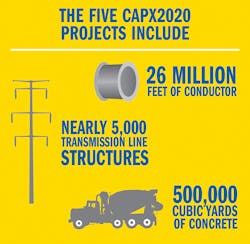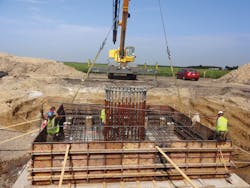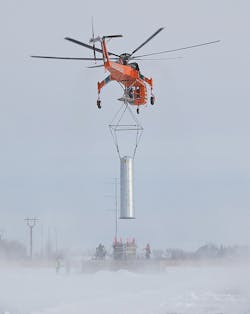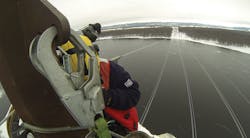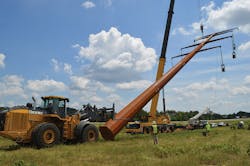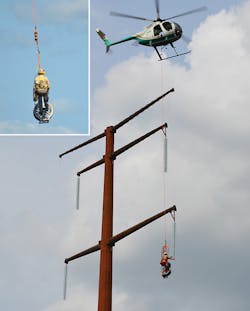After a 13-year effort, the $2 billion CapX2020 grid transformation initiative involving 11 utility partners is up and running in the Upper Midwest region of the United States. CapX2020 has set a new standard for regional cooperation in the pursuit of long-term grid reliability, economic sustainability and clean energy. Close to 800 miles (1300 km) of new transmission lines are energized in Minnesota, North Dakota, South Dakota and Wisconsin. The fifth and final CapX2020 project — the 70-mile (113-km), 345-kV Big Stone South-Brookings County line in South Dakota — was completed in late summer 2017. In total, four new 345-kV transmission lines and a 230-kV line have changed the energy landscape in the region for decades to come.
From the start, the CapX2020 utilities decided that a staged approach to transmission development — considering customer costs, addressing reliability, supporting state renewable energy mandates and providing flexibility for the future — would be the most inherently balanced and cost-effective approach. CapX2020 resulted in the largest development of new transmission in the Upper Midwest in more than 40 years.
A Winning Formula
The CapX2020 transmission initiative has been described as unique and innovative. The management and ownership structure guaranteed each of the 11 partner utilities representation, oversight and decision-making authority. The structure balanced efficiency and influence for the largest participants, such as Xcel Energy, while requiring the consent of even the smallest utilities participating in a project for key strategic and financial decisions.
A study published by the University of Minnesota’s Humphrey School of Public Affairs in 2016 said the collaboration of CapX2020 utilities is “ushering in a new era of multistate transmission planning and development that is reshaping the electric power industry.” According to the report, five key characteristics led to the success of the CapX2020 coalition, including setting common goals, creating a win-win situation, building relationships, following group governance, and providing transparency and open communication.
The common goal was a shared vision for change and the reality that working together would lead to success. Part of the willingness to collaborate means more than one utility can win. That attitude is needed for a successful collaboration, because the attitude that a utility can win only if everybody else loses makes collaboration virtually impossible.
Transparency also was key to success. The team stressed the importance of communication and early engagement. Members even did some research into a controversy in the 1970s involving violence when new transmission was being built between North Dakota and Minnesota. During the project, vandals tore down structures and people were arrested. One of the main goals for CapX2020 was to ensure the public knew their voices were being heard during the process.
The Road to Renewables
Transmission provides options; without it, there is no road to get electricity to market. There would not be the new tax revenue generated by wind farms, the royalty payments to landowners or the resulting new jobs. The robust grid created by the CapX2020 projects has reliability benefits and provides economic options by enabling customers to access the least-expensive generation.
Today, there are at least nine wind projects and one natural-gas generation facility in South Dakota requesting to interconnect to the Big Stone South-Brookings County line and the new Big Stone South substation. Xcel Energy’s 600-MW Crowned Ridge wind project will be the largest in South Dakota and result in tens of millions of dollars funneling into the state. Another 10 projects, totaling 1900 MW of wind energy, are seeking to interconnect to the Brookings County, South Dakota-Hampton, Minnesota line.
These two CapX2020 projects were approved by the Midcontinent Independent System Operator (MISO) in December 2011 as multivalued projects (MVP) to help expand and enhance the region’s transmission system, reduce congestion and provide access to affordable energy sources, and they are meeting their mandate.
The approximate 3600 MW of wind proposed to interconnect to the two MVP lines in Minnesota and South Dakota will avoid 6.3 million tons of carbon-dioxide emissions per year and generate approximately $15 million in annual landowner royalty payments. The proposed Crowned Ridge wind farm will create 600 construction jobs and 35 full-time jobs. All of the CapX2020 projects are helping to strengthen the local and regional grids as well as provide lower-cost clean energy to customers and communities across the Midwest.
Xcel Energy has been a major wind energy provider for more than a decade, and wind energy supplies nearly 20% of the power companywide. In 2017, Xcel Energy announced plans to grow the company’s wind portfolio 50% by 2021. The CapX2020 transmission lines are helping to continue the path to bring low-cost wind energy to Xcel Energy customers.
Construction Challenges
Over the course of the years, crews faced many construction challenges building these lines and substations, including working in record cold temperatures, dealing with unstable soil conditions and crossing the Mississippi River.
The Mississippi River crossing included constructing a triple-circuit transmission line, part of the 345-kV Hampton-Rochester-La Crosse project. The work traversed the Minnesota-Wisconsin border for more than 1 mile (1.6 km) and included the construction of two tower locations — one on an island and the other on a peninsula — accessible only by water. Barges were used to carry hundreds of loads of concrete, a 250-ton crane (227-tonne) and numerous structure pieces weighing more than 100,000 lb (45,359 kg) each.
Several local contractors helped with the crossing effort, and Xcel Energy crews installed the poles and conductor. Linemen were dropped from helicopters onto the structures to help install the lines over the river at the end of the project.
Other challenges on the Hampton-Rochester-La Crosse project included moving a 400,000-lb (181,437-kg) transformer into a new substation in Wisconsin. A remote-controlled trailer took the transformer off road, through a field, because bridge weight restrictions prevented crews from using the road for the move.
CapX2020 crews built structures in several wetlands, some with water 20 ft to 30 ft (6 m to 9 m) deep. On the Fargo-St. Cloud-Monticello project, crews used a heavy-lift helicopter to set two 150-ft (46-m) structures in a wetland area in Minnesota. The work was done in the middle of winter because crews were unstable to build an ice road.
One of the things people along the line or driving by would mention the most was the helicopters. Helicopters were used a great deal on the projects, including assisting in stringing conductor and attaching components. The helicopters saved time and helped to avoid placing more equipment in the right-of-way. Thousands of polymer and wood mats also were used to reduce land compaction on the right-of-way as well as improve safety. The mats helped to stabilize the ground for crews, especially in adverse weather conditions and when working in wetlands.
Interphase spacers were installed on portions of the CapX2020 transmission lines to prevent conductor galloping. The 25-ft (8-m), 200-lb (90-kg) spacers are attached vertically on two phases of conductor. Helicopters were used at times to install the spacers, which were designed to prevent excessive conductor movement and potential outages from wind and ice.
Grid Backbone
The five CapX2020 projects included nearly 5000 transmission line structures, more than 26 million ft (7.9 million m) of conductor and 500,000 cubic yards (382,277 cubic m) of concrete, as well as 10 new substations and 12 modified substations:
• The 230-kV Bemidji-Grand Rapids project was energized in 2012 to improve reliability for the Red River Valley, Bemidji, Grand Rapids and north-central Minnesota. The single-circuit line connects the Wilton substation near Bemidji and the Boswell substation in Grand Rapids, both in Minnesota. Construction on the 70-mile (112.7-km) transmission line began in January 2011.
• The 345-kV Brookings County-Hampton project is 250 miles (402 km) and was energized in March 2015. The project helps to meet projected electric growth in southern and western Minnesota as well as the growing areas south of the Twin Cities. The project also connects to new renewable generation resources in southern and western Minnesota and the Dakotas.
• The 345-kV Fargo-St. Cloud-Monticello project is 240 miles (386 km) long and improves community reliability in the southern Red River Valley as well as the Fargo, North Dakota, and Alexandria and St. Cloud, Minnesota, areas. It also improves the movement of renewable energy. The line spans from a new Bison substation west of Fargo to the Alexandria switching station in Alexandria, the new Quarry substation west of St. Cloud, and the substation at the Monticello nuclear generation plant. Construction began in 2010 and the line was energized in April 2015.
• The 161/345-kV Hampton-Rochester-La Crosse project is 155 miles (250 km) and was energized in September 2016. The project spans from the Hampton substation south of the Twin Cities to the North Rochester substation north of Pine Island, Minnesota, and the Briggs Road substation north of La Crosse. The line improves reliability for the Twin Cities, Rochester and La Crosse areas.
• The 345-kV Big Stone South-Brookings County project runs between a new Big Stone South substation near Big Stone City and the Brookings County substation near Brookings, both in South Dakota. Construction began in November 2015 and the line was energized in September 2017.
The Future Is Bright
The CapX2020 partners include Central Municipal Power Agency, Dairyland Power Cooperative, Great River Energy, Minnesota Power, Minnkota Power Cooperative, Missouri River Energy Services, Otter Tail Power Co., Rochester Public Utilities, Southern Minnesota Municipal Power Agency, WPPI Energy and Xcel Energy.
This is an exciting and transformational time in the industry, and the CapX2020 lines and collaborative transmission model are adding to the new realm of possibilities for the future of the electric grid. ♦
Teresa Mogensen is senior vice president, transmission at Xcel Energy and is responsible for all aspects of Xcel Energy’s current and future electric transmission system and T&D substations across 10 states. She is president of the Xcel Energy transcos, several transmission-only subsidiary companies engaged in competitive transmission growth opportunities. Mogensen holds MBA and BSEE degrees from Marquette University.
Check out the January 2018 issue for more articles, news and commentary.
About the Author
Teresa Mogensen
Senior Vice President, Transmission
Teresa Mogensen is senior vice president, transmission at Xcel Energy and is responsible for all aspects of Xcel Energy’s current and future electric transmission system and T&D substations across 10 states. She is president of the Xcel Energy transcos, several transmission-only subsidiary companies engaged in competitive transmission growth opportunities. Mogensen holds MBA and BSEE degrees from Marquette University.

